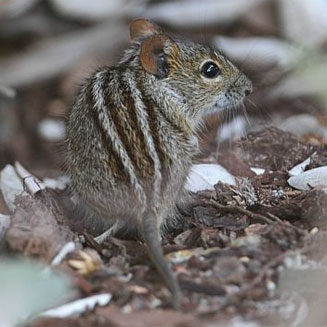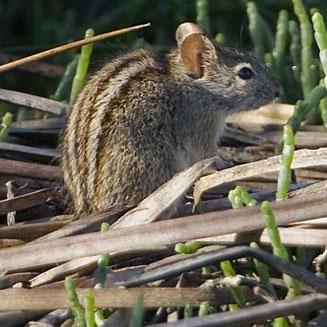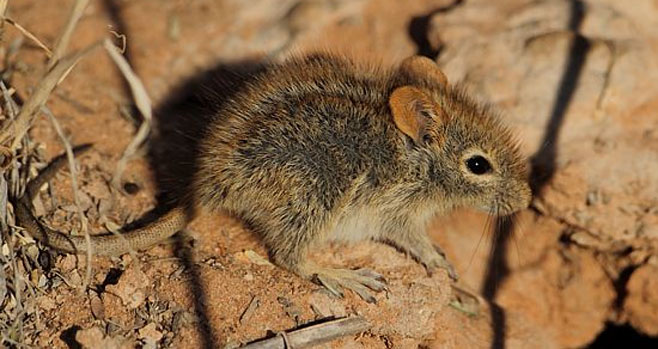|
Rhabdomys pumilio
(Four-striped grass mouse, Striped field mouse, Striped mouse)
streepmuis
[Afrikaans];
Streifengrasmaus [German];
rat de champ raye [French];
tadi, thetwane [Setswana]
Life
>
Eukaryotes >
Opisthokonta >
Metazoa (animals) > Bilateria > Deuterostomia >
Chordata > Craniata > Vertebrata (vertebrates) >
Gnathostomata (jawed vertebrates) > Teleostomi (teleost
fish) > Osteichthyes (bony fish) > Class:
Sarcopterygii (lobe-finned fish) > Stegocephalia
(terrestrial vertebrates) > Reptiliomorpha > Amniota >
Synapsida (mammal-like reptiles) > Therapsida > Theriodontia
> Cynodontia > Mammalia (mammals)
> Placentalia (placental mammals) >
Euarchontaglires > Glires > Rodentia (rodents) >
Sciurognathi > Family: Muridae (rats and mice)
> Subfamily: Murinae
 |
 |
|
Four-striped grass mouse, Intaka Island Wetland
Reserve, South Africa. [photo Trevor Hardaker ©] |
Four-striped grass mouse, West Coast National
Park, South Africa. [photo Trevor Hardaker ©] |
 |
|
Four-striped grass mouse, Kgalagadi Transfrontier
Park, South Africa. photo Trevor Hardaker ©] |
Description
As its common name suggests the four-striped
grass mouse is easily identified by the 4 distinct dark longitudinal
stripes running the length of the back. Colour varies from dark
grizzled russet brown to a gray-white. The sides and underparts are
lighter but vary from off-white to pale grey-brown. The backs of the
ears and the snout are russet to yellowish brown. The upper surfaces
of the feet are usually lighter in colour than the body. Research
has shown that the average body size does vary in different
geographical areas, and that tails can be shorter or equal to the
body length.
Size
Body length 18 - 21 cm; weight range 30
-55 g
Dental formula
I
 C C P P M M =
16 =
16
Distribution and habitat
Widely distributed in South Africa and Namibia,
with patchy occurrence in Botswana, Zimbabwe and Mozambique. It has
a wide habitat tolerance, from desert fringe to high-rainfall
mountain areas, but does require the presence of grass.
General Behaviour
Striped mouse are active during the day, but
are seldom active at night as they cannot maintain their body
temperature if the environment is below 5 degrees C. They excavate a
burrow system with the entrances well concealed in clumps of grass
and create a radiating system of runways with their regular
excursions to the feeding grounds. They are common around houses.
Food
The four-striped grass mouse is an omnivore,
eating seeds, other plant material, and insects. Its diet varies
seasonally. It builds up fat stores that assist it to survive in
times of limited food supply. Green plant material forms the largest
portion of the diet with seed consumption higher in the summer
months. The insect component of the diet seems to be fairly
consistent.
Reproduction
During the breeding season the adult females
appear to be territorial and have a reduced home range. Litters are
usually born in summer after a 25 day gestation period. Average
litter size is 5-6 altricial (helpless and blind) young. At birth
the four dark stripes are visible as deeply pigmented lines in the
skin. The young are born in grass nests either within the burrow
system or above ground. They only begin to wander from the nest
after 14 days. Life span: 18 months
Conservation
Currently there is no conservation status for
the four-striped grass mouse.
Text by Denise Hamerton |
